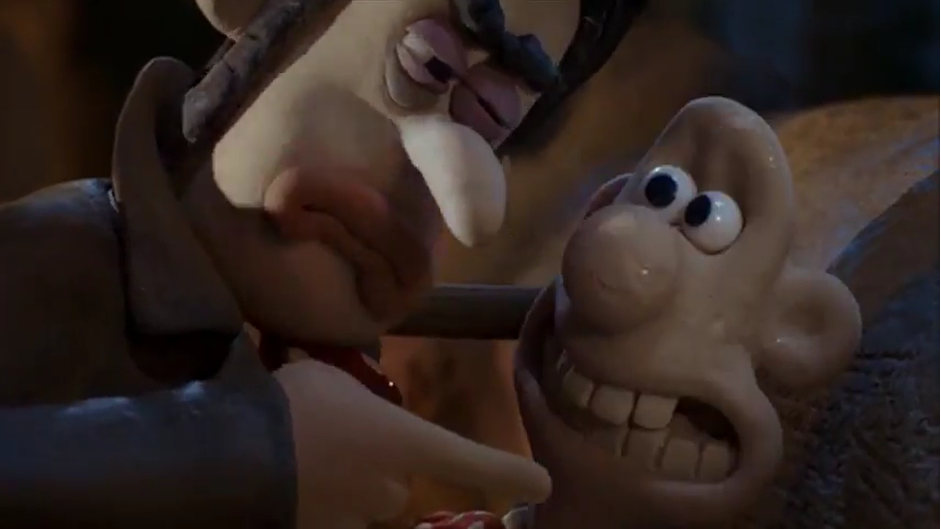
In this post, I want to move on from the simple evocation of a celebrity’s past roles to focus on the ‘vocal’ aspect of celebrity vocal stardom. Fiennes’ next animated villain, Lord Victor Quartermaine, would appear in 2005’s Wallace and Gromit: The Curse of the Were-Rabbit, and I think it is instructive to analyze some of the vocal strategies that work to characterize his villain. Vocals are a highly effective shorthand for shaping characters and can play with our expectations of a character, and that is certainly true of Victor.
The film sees Wallace (Peter Sallis) and Gromit set up a pest control business to help humanely dispose of rabbits before an annual giant vegetable competition run on the estate of Lady Tottington (Helena Bonham Carter). After an experiment goes wrong, Wallace starts transforming into a giant were-rabbit at night, and is pursued by Victor, a self-centred hunter and rival for Lady Tottington’s affections.
The accent is the most obvious marker of the difference between Victor and Wallace. Wallace has a North Yorkshire accent, and his slow, gentle inflection indicates he is the opposite of Victor in terms of both class and temperament. Indeed, the presence of Sallis evokes the popular BBC comedy Last of the Summer Wine (1973-2010), in which he played a mild-mannered widower – his gentle voice is a stark contrast to the brash and hammy tone that Fiennes uses for Victor.
Fiennes’ vocal tone is noticeably lower than the other major male speaking characters – Wallace, Reverend Hedges (Nicholas Smith) and PC Mackintosh (Peter Kay) – all of whom have lighter and more lyrical inflections in their voices, which suggests Victor’s distinction from our hero and the townsfolk and implies his villainy to the audience. It also suggests a sense of authority about his character, as is evident through the town’s decision to allow him to deal with the were-rabbit problem in a lethal fashion. In a later sequence, he employs a lower, more authoritative tone to demand that the vicar explains how to kill the creature. A lower tone tends to imply masculinity and stereotypical masculine traits (Collins 2000), something that manifests in Victor’s case as arrogance and bravado and makes him unappealing to the viewer.
The actor’s vocal performance exaggerates his refined speaking voice, conforming to our conventional ideas of how an upper-class figure should sound. His inflection rises up when he uses archetypal phrases like ‘what ho!’ and ‘what the dickens?’, and the deliberately hammy tone is an indication that Victor is a parodic version of a respectable English gentleman (Foley 2005). He also interjects much of the dialogue about himself with conceited and casual laughter, a choice by Fiennes which encourages us to think of Victor as a show-off, and implies that his first and abiding interest is himself – something his actions go on to support.
Fiennes lays stress on certain sounds when he speaks, which shapes how we perceive Victor as a negative character. We first meet Victor at Tottington Hall, where he hopes to impress Lady Tottington and eliminate her rabbit infestation with lethal force. He describes the rabbits as ‘blighters’, ‘pests’ and ‘vermin’, and he carefully accentuates the harsh contestant sounds at the start of these words. It is a subtle technique that draws attention to these terms, showing the viewer that Victor thinks little of the animals, and it encourages us to distrust him – by carefully stressing these harsh sounds in loaded negative words, we are inclined to think that Victor is a punitive person. This is compounded by the relish-filled way with which Victor talks about ‘crushing’ or ‘liquidizing’ the rabbits, a stark contrast to his confused, distasteful enunciation of the word ‘humane’.

A similar effect is employed later in the film when Victor confronts over supposedly stealing Lady Tottington from him (he intends to marry her for her money). The sequence uses a lot of words beginning with ‘p’, and Fiennes stresses each ‘p’ sound with a sharp staccato burst. He refers to Wallace as ‘Pesto’ (the name of his pest control business), and demands to know why Wallace thinks he can ‘pilfer my filly’. His voice raises slightly as he states that he is ‘not about to let some puddle-headed peasant poach her from me’, and he later refers to him as a ‘pipsqueak’ who needs to be taught a lesson. The sequence is intended to be threatening, as Victor lays a trap for Wallace to scare him away, and Fiennes’ vocal control is key to this – the harsh ‘p’ sounds are menacing and harsh even in the absence of physical force.
A set of careful vocal strategies work to shape our understanding of Victor as a villainous character. We initially use Fiennes’ hamming up his accent to code Victor as a posh and egotistical figure indifferent to the lives of others. However, the stress that he lays on certain words and sounds indicates to the viewer that he is a genuine threat to Wallace. In Fiennes’ voice, we hear the two sides of this character – his vocals imply lots about Victor, and help layer his personality.
References
Collins, Sarah A. (2000). “Men’s voices and women’s choices.” Animal Behaviour, 60 (6), pp. 773-780
Foley, Jack (2005). “Wallace & Gromit – Nick Park interview.” IndieLondon, http://www.indielondon.co.uk/film/wallace_gromit_curse_park.html
Reece Goodall is a PhD student at the University of Warwick, working on an industrial, cultural and theoretical analysis of French horror cinema. His research interests include horror cinema, genres, transnational genres, and authorship as well as the interplay between popular media, news, and politics.
